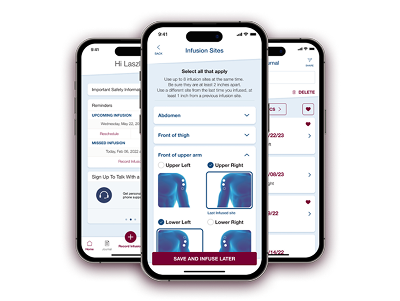WARNING: Thrombosis (blood clots) can occur with immune globulin products, including Hizentra. Risk factors can include: advanced age, prolonged immobilization, a history of blood clotting or hyperviscosity (blood thickness), use of estrogens, installed vascular catheters, and cardiovascular risk factors.
If you are at high risk of blood clots, your doctor will prescribe Hizentra at the minimum dose and infusion rate practicable and will monitor for signs of clotting events and hyperviscosity. Always drink sufficient fluids before infusing Hizentra.
See your doctor for a full explanation, and the full prescribing information for complete boxed warning.
Hizentra®, Immune Globulin Subcutaneous (Human), 20% Liquid, is a prescription medicine used to treat:
- Primary immune deficiency (PI) in patients 2 years and older
- Chronic inflammatory demyelinating polyneuropathy (CIDP) in adults
Treatment with Hizentra might not be possible if your doctor determines you have hyperprolinemia (too much proline in the blood), or are IgA-deficient with antibodies to IgA and a history of hypersensitivity. Tell your doctor if you have previously had a severe allergic reaction (including anaphylaxis) to the administration of human immune globulin. Tell your doctor right away or go to the emergency room if you have hives, trouble breathing, wheezing, dizziness, or fainting. These could be signs of a bad allergic reaction.
Inform your doctor of any medications you are taking, as well as any medical conditions you may have had, especially if you have a history of diseases related to the heart or blood vessels, or have been immobile for some time. Inform your physician if you are pregnant or nursing, or plan to become pregnant.
Infuse Hizentra under your skin only; do not inject into a blood vessel.
Self-administer Hizentra only after having been taught to do so by your doctor or other healthcare professional, and having received dosing instructions for treating your condition.
Immediately report to your physician any of the following symptoms, which could be signs of serious adverse reactions to Hizentra:
- Reduced urination, sudden weight gain, or swelling in your legs (possible signs of a kidney problem).
- Pain and/or swelling or discoloration of an arm or leg, unexplained shortness of breath, chest pain or discomfort that worsens on deep breathing, unexplained rapid pulse, or numbness/weakness on one side of the body (possible signs of a blood clot).
- Bad headache with nausea; vomiting; stiff neck; fever; and sensitivity to light (possible signs of meningitis).
- Brown or red urine; rapid heart rate; yellowing of the skin or eyes; chest pains or breathing trouble; fever over 100°F (possible symptoms of other conditions that require prompt treatment).
Hizentra is made from human blood. The risk of transmission of infectious agents, including viruses and, theoretically, the Creutzfeldt-Jakob disease (CJD) agent and its variant (vCJD), cannot be completely eliminated.
The most common side effects in the clinical trials for Hizentra include redness, swelling, itching, and/or bruising at the infusion site; headache; chest, joint or back pain; diarrhea; tiredness; cough; rash; itching; fever, nausea, and vomiting. These are not the only side effects possible. Tell your doctor about any side effect that bothers you or does not go away.
Before receiving any vaccine, tell immunizing physician if you have had recent therapy with Hizentra, as effectiveness of the vaccine could be compromised.
Please see full prescribing information for Hizentra, including boxed warning and the patient product information.
You are encouraged to report negative side effects of prescription drugs to the FDA. Visit www.fda.gov/medwatch, or call 1-800-FDA-1088.
You can also report side effects to CSL Behring's Pharmacovigilance Department at 1-866-915-6958.







